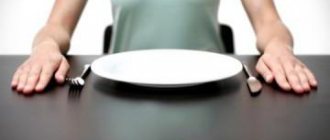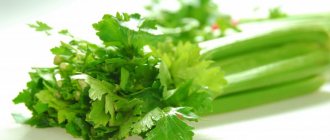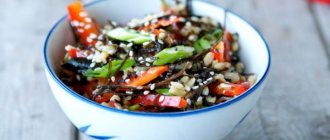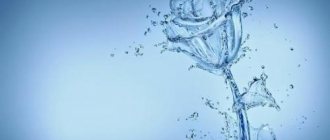The essence of the Japanese diet for 14 days
The optimal duration of the Japanese diet is 2 weeks or 14 days. In this case, a person losing weight will need to eat foods that are low in calories. There are few carbohydrates per day, the main emphasis is on proteins.
For a full two-week weight loss course, no more than 2,000 rubles will be spent. In this case, you will be able to lose about 5-8 kg. However, you need to immediately tune in to the fact that the Japanese diet is strict and requires a certain amount of endurance from a person.
If, after completing the weight loss process, you leave the diet according to all the rules, the results will last for a long time.
The Japanese diet has some restrictions. For example, it is not recommended for use by pregnant women or nursing mothers. People suffering from gastritis or stomach ulcers, kidney and liver diseases, and cardiovascular pathologies should not adhere to the menu presented below. But even if a person does not have serious health problems, before going on a diet, you should definitely consult a doctor.
How to choose the right products?
Breakfast in the Japanese diet consists mainly of coffee, because it is this invigorating drink that allows you to start and accelerate your metabolism. A cup of coffee does not harm people in complete health, even if they consume it on an empty stomach (after drinking a glass of warm water). However, the most important condition is that the coffee must be of high quality. It is unacceptable to use “3 in 1” coffee or low-grade powdered drink during the diet. If a person cannot drink natural coffee, then it can be replaced with high-quality green tea.
Cabbage is one of the staple foods in the Japanese diet. In addition to the fact that it has low calorie content, the body spends more energy on its digestion than it receives. Cabbage is also a valuable source of fiber, which allows the intestines to function normally. It is important to choose medium-sized forks to avoid rot or mold. The same applies to the choice of carrots.
Chicken and beef, which are used in the Japanese diet menu, must be fresh. It is best to take chilled rather than frozen meat. The product must be low in calories, so chicken breast and lean beef fillet are used to prepare the dishes.
You should also choose low-fat fish, but it should be sea and not river. For example, you can use fillets of hake, cod, whiting and sea bass. Suitable for steaming or oven-cooking haddock, pollock and navaga. In addition to the fact that these sea inhabitants have low calorie content, they are also 100% absorbed by the body.
To create a menu, you will also need chicken eggs, tomato juice, olive oil, low-fat cheese, kefir and fruit. You can use almost any fruit except bananas and grapes.
Why is the diet called “Japanese”?
Surely a person who hears the phrase “Japanese diet” for the first time immediately imagines a menu with an emphasis on rice, soy sauce, seafood and other favorite dishes of this eastern country. In fact, the only thing that will remind you of Japan on the menu will be boiled fish and, possibly, boiled eggs. The diet does not involve any delights or exotics. All products are well known to Russians, which is a definite advantage of such a diet, since the risk of developing an allergic reaction is minimized. In addition, all products are freely available and are not expensive at all, so there will be no problems finding ingredients for cooking.
It’s difficult to say why the diet is called Japanese.
There are two versions of the origin of the name of the diet:
- There is an assumption that the menu was compiled by nutritionists from a clinic in Tokyo.
- According to another version, the diet is called Japanese because of the clear and simple scheme of its use. By adhering to the basic rules of dietary nutrition, a person will definitely get the desired result. This is very similar to the Japanese philosophy: give your best and you will be rewarded.
It is also known that the Japanese are very reserved when it comes to food. They eat food in small portions, each of which consists of low-calorie foods. This is the principle that forms the basis of the diet. The famous Japanese nutritionist Naomi Moriyama believes that it is the moderate consumption of food by her compatriots that allows them to break all longevity records.
Naomi conducted a comparative analysis, as a result of which it was possible to establish that the Japanese consume on average 25% fewer kilocalories per day than residents of other countries. Butter, chocolate, chips and baked goods are not popular in the Land of the Rising Sun. We can say that moderation in food is one of the features of culture. The same distinctive feature is inherent in the Japanese diet.
Permitted and prohibited products
Allowed to use:
- cottage cheese;
- yogurt;
- squash caviar;
- boiled chicken and beef;
- vegetable oil;
- applesauce;
- tomatoes;
- cucumbers;
- boiled fish fillet;
- carrot puree.
Important: These products can be consumed no more than 100 g.
It is prohibited to use:
- baked goods;
- confectionery;
- honey;
- nuts;
- fatty fish and meats;
- butter;
- sweets;
- alcohol;
- soda.
Rules for an effective Japanese diet
Russians, unlike the Japanese, are not used to limiting their food intake, so following such a diet can be quite problematic for them. Moreover, it is actually strict, although a person receives fats, proteins, and carbohydrates.
Sources of carbohydrates include vegetables, fruits and crackers. Fats enter the body along with olive oil, fish and meat. A person will get proteins from chicken, eggs, dairy products, fish and beef. There will be no disturbances in the functioning of the digestive organs, since the fiber necessary for the intestines is present in the diet in sufficient quantities. It is found in abundance in vegetables and fruits, which on some days can be eaten with almost no restrictions.
Also, while following a dietary diet, a person is allowed to drink coffee and green tea. These drinks not only perfectly tone you up, but are also a source of antioxidants. But for this you need to purchase only high-quality tea and coffee.
There is a convenient application for Android devices - Japanese Diet, which provides its users with a different menu for every day. It is convenient to make a shopping list and receive a variety of information about your diet. But this application has one drawback - it only works in English, although for most Russians this is not a problem.
Despite the fact that the body receives all the substances necessary for life, their quantity is very limited. Therefore, you cannot stick to the Japanese diet for more than two weeks. In addition, if, while following a dietary diet, you suddenly feel unwell, have body aches or headaches, then you need to leave the diet. If possible, you should see a doctor.
While following the Japanese diet, it is very important to maintain an adequate drinking regime. You need to consume at least 1.5-2 liters of clean water without gas per day. It's good if it's at room temperature. This will not only reduce the feeling of hunger by filling the stomach, but will also allow the intestines to perform their functions normally.
If you strictly follow all the rules of the Japanese diet, then losing weight in 14 days is quite possible. You cannot replace one product with another at your own discretion, even if it seems that they are very similar. Unless your morning cup of green tea can be easily replaced with a serving of coffee and vice versa. But adding sugar or milk to the drink is strictly prohibited. By the way, salt will also need to be removed from the menu, or food should be seasoned with it in minimal quantities.
You can only come to the table three times a day instead of the usual 5-6 meals. Snacks are not included in the diet. The last meal should be no later than two hours before bedtime. Be sure to drink a glass of warm water every morning on an empty stomach. This will start metabolic processes, and will also make it easier to tolerate the absence of breakfast.
The body must be prepared in advance before entering the diet. For about a week, you should stop eating sweets and fast food. From this time you need to start reducing portion sizes. The psychological attitude towards the upcoming hunger strike is no less important. Perhaps the fact that after completing the diet (provided you follow all the rules) you will be able to get rid of at least 5 kg will give you strength.
Rules
The Japanese diet for 14 days has an original version and a slightly modified one, adapted to the life of a modern person, designed for 7 or 13 days. In the second case, to reduce the load on the kidneys, fasting days are carried out with the addition of carbohydrates to the diet. But regardless of the type, the rules remain the same:
- It is recommended to stick to the prepared menu and not exceed the established portion sizes. It is not advisable to swap meals or replace one food with another.
- Complete refusal of sugar and salt.
- It is necessary to strictly observe the drinking regime, drink at least 1.5-2 liters of clean drinking water without gas. This is necessary to remove protein breakdown products and normalize kidney function.
- You should eat strictly in accordance with the scheme and schedule. Snacks are prohibited.
- The last meal should be taken 3-4 hours before going to bed.
- It is better to exclude intense training on the Japanese diet, since it requires carbohydrates. As an option, you can stick to leisurely stretching and non-strength yoga.
- It’s not easy for the body during a diet; it experiences enormous stress and overload. It is necessary to help him, give him rest. The best way to do this is to improve your sleep patterns.
- You need to exit the diet smoothly and consistently. Otherwise, all the lost kilograms will return, even in large quantities.
Throughout the diet, you need to carefully monitor your well-being. Any malaise, weakness, or headache may indicate serious disorders in the body. The Japanese diet should be abandoned immediately. Why test the body's strength if by now doctors at weight loss clinics have a huge number of tools for safe, effective weight loss without stress, breakdowns, or side effects?
Products for the Japanese diet for 14 days
The list of necessary products must be studied in advance so that there is no need to replace any component with another. Moreover, this will negatively affect the results of the diet.
Beverages:
- A pack of green tea, which should not contain any additives or flavorings.
- A pack of ground or bean coffee. The only condition is that the coffee must be of high quality.
- A liter of tomato juice.
- A liter of kefir, which must be fresh.
Vegetables and fruits:
- Two forks of white cabbage. Cabbage should be medium in size.
- Half a kilo of zucchini and eggplant.
- Two to three kilograms of carrots.
- One kilogram of any fruit. Only bananas and grapes are prohibited.
- Two lemons.
Meat and fish:
- A kilogram of lean beef.
- A kilogram of chicken fillet.
- Two kilograms of sea fish fillet.
Other products:
- 20 chicken eggs.
- 0.5 liters of cold pressed olive oil.
What is the Japanese water diet
The essence of the system is that you need to increase the amount of water consumed per day. The norm for a person is 30 ml of liquid per 1 kg of weight. Few people drink so much water, because the daily bustle pushes this task into the background.
The Japanese diet for weight loss controls fluid intake and promotes the loss of extra pounds. You can get rid of 1-1.5 kg per day. Water drunk 20-30 minutes before meals dulls the feeling of hunger . Thanks to this, a person eats less food, because part of the stomach is occupied. Need I say how beneficial water therapy is for the skin and internal organs? Cells saturated with moisture function much better, and with an optimal amount of water, metabolic reactions proceed correctly. Patient and persistent people can drink water and not eat for three days on an express diet. Fat deposits in problem areas will begin to quickly break down.
Prohibited and permitted products
In a gentle version of the Japanese water diet, you can eat healthy foods. They should be low-calorie, non-starchy, properly prepared (boiled, baked, stewed, steamed). Choose low-fat dairy products and cold-pressed vegetable oils. List of permitted foods that form the basis of the menu:
- chicken, beef, veal;
- low-fat fish;
- tomatoes, cucumbers, carrot puree, squash caviar, cabbage and seaweed, dill, parsley;
- applesauce, pear puree, oranges, grapefruits, blueberries, raspberries;
- olive, sesame, flaxseed, pumpkin oil;
- cottage cheese 5%, natural yogurt without additives.
The quantity of each product per day is no more than 100 g. The list of foods prohibited on the diet is wide. It includes confectionery and flour products, sweet carbonated drinks, alcohol, fried, smoked, and canned foods. You cannot eat processed foods or fast food. On the Japanese water diet, it is prohibited to consume the following healthy foods:
- honey;
- nuts, pumpkin seeds, sunflower seeds, sesame seeds, flax seeds;
- fatty fish;
- potatoes, cereals, durum wheat pasta;
- sweet fruits, dried fruits;
- sour cream, cream.
Pros and cons of the diet
The system of losing weight and cleansing the body is popular among men and women due to its simplicity, low cost and excellent results. On the Japanese water diet you do not need to change your diet much. In a minimum time, you will remove accumulated toxins from the intestines, remove harmful salts, and saturate the cells with moisture. The skin will become more elastic, fresh, and acquire a healthy color. If you continue to eat right, the weight you lost will not come back.
Disadvantages are observed with a strict diet option, when the diet menu is meager or there is no food in the diet. A person may feel severe hunger, weakness, nausea, and dizziness. He is urinating more frequently. The kidneys are under increased stress. In 1 hour they pass up to 1 liter of water, so you shouldn’t get too carried away with water therapy. Electrolytes are washed out of the body, so the duration of the diet is no more than three days.
Before implementing water therapy, it is advisable to consult with your family doctor. The Japanese weight loss system has many contraindications. The diet cannot be used in the following cases:
- heart pathologies, unstable blood pressure;
- diseases of the kidneys, bladder, tendency to edema;
- cholecystitis;
- diabetes;
- nervous system disorders, emotional instability;
- gastritis, ulcer;
- infectious diseases (bacterial and viral);
- serious illnesses, exacerbation of chronic ailments;
- The technique is prohibited for pregnant women and lactation.
Japanese and “chemical” diets for diabetics: what do they have in common?
If we draw analogies between the Japanese diet and other diets for weight loss, then it is as close as possible to a “chemical” diet. The latter was proposed by the American doctor Osama Hamdiy and is intended for the treatment of obesity in people with diabetes.
The Japanese diet also involves a sharp limitation of carbohydrate foods, but at the same time an increase in protein foods in the menu. This allows you to trigger certain chemical reactions in the body that are aimed at burning fat. In this case, no new deposits appear.
However, Osama Hamdiy’s diet is different in that the amount of food eaten is not limited to any portions. At the same time, someone losing weight can exercise, but he will not feel exhausted. In turn, the Japanese diet involves eating fairly monotonous food, but it is not very long. 14 days is enough to reduce your clothing size by about 2 points.
Contraindications
The Japanese Medical Association has proven that if you drink lemon water daily, you can get rid of many modern diseases and make your body much slimmer and more toned.
Like any therapeutic diet, the Japanese water healing technique has a number of limitations. It is contraindicated for people suffering from diabetes mellitus, infectious and viral diseases, gastritis or acute ulcers, cholecystitis, functional disorders of the nervous system, unstable blood pressure, kidney and urinary tract diseases, as well as a tendency to edema.
Pregnant and nursing mothers should avoid treatment with Japanese hydrotherapy.
Japanese diet menu for 14 days
- The first day:
- There is no breakfast as such. In the morning, after a glass of water, you are allowed to drink empty coffee.
- For lunch, eat boiled cabbage, 2 boiled chicken eggs and wash it all down with a glass of tomato juice.
- Dinner should consist of fish (200 g). It can be boiled or fried.
- Second day:
- You can have breakfast with coffee without any additives and a piece of rye bread.
- For lunch, cabbage is boiled again, which is supplemented with 200 g of boiled or fried fish. Cabbage is seasoned with vegetable oil.
- Dinner consists of a glass of kefir and boiled beef (100 g).
- Day three:
- For breakfast, they again drink empty coffee, which can be supplemented with biscuits or a piece of rye bread.
- They dine with zucchini or eggplant, which is fried in oil. The number of vegetables can not be limited.
- Dinner consists of raw cabbage with the addition of vegetable oil, boiled beef without salt (200 g) and 2 boiled eggs.
- Day four:
- You are allowed to eat fresh carrots for breakfast. It can be ground and seasoned with lemon juice.
- For lunch, eat 200 g of fish (boiled or fried), washed down with a glass of tomato juice.
- Dinner consists of any fruit, but their volume is limited and amounts to 200 g.
- Day five: This day completely repeats the menu of the fourth day.
- Day six:
- You need coffee for breakfast.
- For lunch, you should boil half a kilo of chicken breast without adding salt. The side dish is a salad of fresh cabbage and carrots with vegetable oil dressing.
- For dinner you can eat carrots and two boiled eggs.
- Day seven:
- There is no breakfast. Instead, you need to drink a glass of green tea.
- Lunch consists of 200 g of boiled beef.
- Eat fruit for dinner (200 g). Alternatively, you can diversify the menu with fresh carrots with vegetable oil and 2 eggs, or 200 g of fried fish, or 200 g of boiled beef. Any of the listed sets of products should be supplemented with a glass of kefir.
- Day eight:
- Breakfast, as usual, consists of a glass of coffee.
- For lunch, eat half a kilo of boiled chicken breast, which is complemented with a side dish of fresh cabbage with vegetable oil.
- Dinner is a couple of eggs and carrots with butter.
- Day nine:
- For breakfast you need to grate carrots and season them with lemon juice.
- At lunch, drink a glass of tomato juice and eat a piece of boiled or fried fish (200 g).
- Dinner consists of fruit (200 g).
- Day ten:
- In the morning you only need to drink a glass of coffee without additives.
- For lunch you are allowed to eat 3 small carrots, cheese (50 g) and a boiled egg. Carrots can be grated and seasoned with vegetable oil.
- Day eleven:
- Breakfast consists of a slice of rye bread and a glass of coffee.
- For lunch, you can fry zucchini or eggplant in oil. You are allowed to eat as much as you want.
- For dinner, boil beef (200 g), 2 eggs and make cabbage salad with vegetable oil dressing.
- Day twelve:
- They have breakfast again with a piece of rye bread and a glass of coffee.
- For lunch, you are allowed to eat boiled or fried fish and complement it with fresh cabbage salad with vegetable oil.
- Dinner consists of a glass of kefir and boiled beef (200 g).
- Day thirteen:
- Breakfast includes a glass of coffee without sugar.
- For lunch, boil 2 eggs and cabbage, wash down the dish with tomato juice.
- They dine with a piece of fish, which can be fried or boiled.
- Day fourteen:
- They only drink coffee for breakfast again.
- They dine on fish and fresh cabbage salad with butter.
- For dinner you are allowed to eat boiled beef weighing 200 g and wash it down with a glass of kefir.
It is believed that the Japanese diet is exactly the weight loss method that gives the most lasting results. It can persist for 3 years or more. However, in order to achieve the desired weight, you need not only to stay on a diet for 14 days, but also to monitor your diet in the future. The main rule is moderation in food and choice towards natural, healthy products. This is exactly what the Japanese diet teaches.
Quitting the diet
The first week of leaving the Japanese diet is an extremely important period. At this time, the body continues to lose weight and adapt to new parameters, so it is important not to pounce on food, but to slowly introduce familiar foods into the diet. They must be exclusively natural.
- In order for the achieved result to be consolidated, you should exit the diet gradually. The exit period should last twice as long. So, the period of exit from the 14-day Japanese diet should last no less than 28 days - that is, 4 weeks.
- In the first week, gradually increase the consumed portions of meat and fish dishes - by 50 g, vegetables - by 100 g.
- For breakfast, eat porridge cooked in water (buckwheat, oatmeal, rice) and omelettes. Your single serving should be about 200 g.
- You should add salt to your food gradually: at the beginning of your diet, consume no more than 5 g of salt per day.
- During the day you need to make 2-3 snacks from fermented milk products and fruits.
- Replace a fruit dinner with a full meal of vegetables and proteins (for example, 200 g of vegetable stew and a steamed chicken cutlet).
- Do not reduce the amount of protein foods.
- Eat small meals (5-6 times a day).
Approximate menu for quitting the Japanese diet for 2 weeks
Day 1-3
- Breakfast: omelet of 2 eggs and 150 ml of milk (2.5% fat), 1 piece of bread, black coffee.
- Lunch: 200 g of boiled beef or 200 g of baked cod, 100 g of fresh vegetables.
- Dinner: 100 g of cottage cheese (5% fat) or 250 ml of kefir (2.5% fat) and 1 apple.
Day 4-6
- Breakfast: 200 g of oatmeal with water (no sugar or butter).
- Snack: 1 orange, 1 kiwi.
- Lunch: 200 g baked chicken breast, 100 g fresh vegetables (cabbage, carrots, peppers).
- Dinner: 200 g of boiled shrimp or 150 g of cottage cheese (7% fat), 1 cucumber.
Day 7-10
- Breakfast: 200 g of oatmeal in water without sugar and butter, 2 pieces of toast (20 g each).
- Snack: 1 any fruit.
- Lunch: 200 g vegetable soup, 100 g boiled beef.
- Snack: 100 g of natural yogurt.
- Dinner: 200 g baked chicken breast, 150 g any steamed vegetables.
Day 8-14
- Breakfast: 200 g of any porridge with nuts, dried fruits and honey (no more than 1 teaspoon), 2 pieces of toast (20 g each).
- Snack: 1 any fruit, 100 g of natural yogurt or cottage cheese (5% fat).
- Lunch: 200 g of any soup with low-fat chicken broth, 150 g of boiled chicken breast, 2 fresh cucumbers.
- Snack: 1 any fruit or 150 g of natural yogurt.
- Dinner: 200 g boiled mussels, 150 g vegetable stew.
- Snack: 200 ml kefir (2.5% fat).
Pros of the Japanese diet
The benefits of the Japanese diet for 14 days are numerous, which is why this diet plan has found such widespread popularity among the masses.
The objective advantages of the Japanese diet are the following:
- The results of using the Japanese diet are very noticeable. In two weeks you can get rid of 5-8 kg.
- If, after completing the diet, you adhere to proper nutrition and eat in moderate portions, then the results obtained can be maintained for an unlimited period of time.
- During the diet, the body is freed from toxins. They go away due to the fact that the diet is completely free of harmful foods, and fiber and large volumes of liquid continue to be supplied. This promotes high-quality intestinal cleansing.
- Diet saves budget. Unlike most other dietary patterns, the Japanese diet does not require any special financial expenditure.
- Many adherents of the Japanese diet note that after it, their complexion improves, fine wrinkles disappear, nails become stronger, and hair stops falling out. It is possible that this effect is due to high-quality cleansing of the body.
- With a smooth entry and gradual exit from the diet, a person’s well-being is not affected and dietary restrictions are tolerated more easily.
- The diet menu does not contain food products that are difficult to find in the market. All of them are freely available all year round.
- The Japanese diet consists of foods that do not pose a danger to Europeans in terms of allergies.
Advantages and disadvantages
The Japanese water diet does not require large material costs and is very easy to implement. If you follow it, you do not need to count the calorie content of each dish you eat or radically change your diet. Its popularity is due to the fact that in a fairly short time, a person is able to get good results for a long period of time.
However, it should be borne in mind that some people may experience a feeling of hunger, weakness, dizziness, frequent urination or symptoms of nausea. One of the disadvantages of the Japanese weight loss method is considered to be the leaching of a certain amount of beneficial vitamins from the human body. In particular calcium and potassium.
Cons of the Japanese diet
If you decide to lose a few kilograms through food restrictions, you need to study all the disadvantages of the Japanese diet in advance. This is very important, as it will prevent health problems.
Among the disadvantages of the Japanese diet, the following factors can be noted:
- The Japanese diet is very strict, and it can be difficult to maintain it without prior preparation, both psychological and physiological.
- The menu consists of three main meals, with breakfast as such being practically absent and no snacks at all. Therefore, the feeling of hunger will constantly haunt a person who is losing weight.
- The set of products for 14 days is quite monotonous.
- The Japanese diet is not balanced in essential nutrients, so following it for more than 14 days can be dangerous to your health.
- This weight loss system is not suitable for everyone and has certain contraindications. In addition to the fact that it cannot be used by people with diseases of the digestive system, such a menu is unacceptable for kidney and heart patients.
Reviews and results
This is a tough diet. All products on the menu have a minimum amount of calories. Therefore, fats will not be deposited in problem areas. Due to a lack of nutrients, the body will begin to break down its own fat tissue. As a result, rapid weight loss occurs. You can lose from 1 to 1.5 kg of excess weight per day. Below are some reviews about the “Japanese” water diet.
Larisa, 32 years old: “For me, this is an extreme type of diet, but I chose it because I needed to quickly lose weight in a few days. I was on a diet of water and bread. Of course, I wanted to eat, but I was starving for a day. I couldn't do it anymore. Lost 1 kg of weight. This is a good result. But I believe there are easier ways to lose weight.”
Alina, 26 years old: “I lost weight on apples and water. Still, apples make it easier to endure hunger. I would say that I didn’t feel it. The water made my stomach so full that I didn’t really want to eat. Sometimes I replaced water with green tea. It has zero calories. I lost weight like this for 3 days. I lost 3 kg. Overall, not a bad diet. In addition, if you wish, you can add permitted products to the menu. I believe that this diet is very effective, and anyone who dreams of becoming slimmer can safely use it.”
Interesting!
Authorized Products
Japanese diet products cannot be replaced with others. Alcohol, baked goods, and pasta should be avoided. Fruits with low sugar and starch content are suitable as dessert: apples, pineapple, oranges, grapefruits. Reviews of the Japanese diet claim that for better results, it is better to even avoid fruits or eat them to a minimum.
You can eat white or brown boiled rice as carbohydrates. Brown has more protein and fiber. But if you don’t like it, you can easily replace it with white.
A person will get protein from seafood such as tuna, trout, salmon, shrimp, snapper, as well as chicken or beef.
Important: Soybeans and tofu are acceptable in Japanese diet recipes. Pork and lamb are excluded.
Interesting reviews
I tried to find for you the most recent reviews for 2015-2016.
Lerochka: I followed the diet for 13 days, minus 6 kg. I was more than pleased with the result. I thought about repeating it in a week. but alas, 7 days after the diet I already gained 3 kg. It turns out that I’m gaining weight as quickly as I lost weight ((Now I’m generally afraid of gaining excess weight
Angela: I stuck to this menu for 13 days, minus 5 kilos. It was difficult for me for the first 3-4 days, then I somehow got into it. So I also have a shift work schedule - day/night. Thanks to the diet, I learned to refuse food at night.
Varya: In one day of the diet I lost 2 kg, the excess fluid probably went away
Alinka: Girls, how did you complete 14 days? I’ve been sitting here for 4 days and it’s already going crazy! There is no hunger, but the general condition is terrible. I’m so weak that I think I won’t be able to get to work soon. I'll quit.
Artem: I’m already on day 5 of the diet. Started with a weight of 97 kg. Minus 5 kg in 5 days... Maybe I’m losing it quickly because I’m gaining a lot of weight.
Gelya: I followed this diet in 2015 and managed to lose 5 kg! I didn’t do sports, I even broke my diet a couple of times. A year has passed and I’ll be riding it for the second time.
Nelya: I’m minus 5 kg, but I messed up my diet. I could add meat or fish, vegetables. For breakfast, in addition to coffee, there was a small piece of rye bread with nuts. I could eat part of the lunch during breakfast. Well, I was always hungry! )) I went in for sports several times a week.
Svetik: The diet is terrible, I’m constantly hungry, my head hurts, I’m irritable. Tomorrow I’m going to visit a friend for a birthday party, but I’ll hold on. I will eat fruits and vegetables))
Asya: I felt bad in the first 2-3 days! It's easier from the fourth. The first days I wanted to eat something smoked, salty or sweet. I didn’t feel dizzy, but I was really delirious about chocolate and candies. ))
Valentina: I broke down at the end of the second week. I have gastritis, and with this diet it became very bad. I think the maximum with my illness is that I need to eat like this for 10 days. Or even 7. I lost 4 kg in 12 days))) I want to try again, although I’ll adjust the menu a little. Otherwise I’ll ruin my stomach completely.
Nata: I completed it in 13 days. In principle, there is nothing complicated. The main thing is without fanaticism. I wanted to lose weight so much that I reduced the portions to 50-100 grams. It’s amazing that she didn’t faint.











